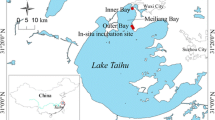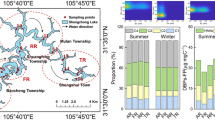Abstract
Dredging, which is the removal of polluted surface sediments from a water body, is an effective means of preventing the formation of algae-induced black blooms. However, an inappropriate dredging time may contribute to rather than inhibit the formation of black blooms. To determine the optimum dredging time, four treatments were simulated with sediment samples collected from Lake Taihu: dredging in January 2014 (DW), April 2014 (DA), July 2014 (DS), and no dredging (UD). Results showed that typical characteristics associated with black blooms, such as high levels of nutrients (NH4 +-N and PO4 3−-P), Fe2+, ∑S2− ([HS−] + [S2−]), and volatile organic sulfur compounds (VOSCs), including dimethyl sulfide (DMS), dimethyl disulfide (DMDS), and dimethyl trisulfide (DMTS), were more effectively suppressed in the water column by DW treatment than by UD treatment and the other two dredging treatments. The highest concentrations of NH4 +-N and PO4 3−-P in the UD water column were 4.09 and 4.03 times, respectively, those in the DW water column. DMS levels in the UD and DS water columns were significantly higher (p < 0.05) than those in the DW water column, but DMDS and DMTS levels were not significantly different between the treatments. After several months of dredging, surface sediments of the DW and DA treatments were well oxidized, and concentrations of Fe2+ and ∑S2− were lower than those in UD and DS treatments because of material circulation between sediments and the water column. Water content, which is important for the transport of matter to the overlying water, was lower in the dredged sediments than in the undredged sediments. These factors can suppress the release of Fe2+ and ∑S2− into the water column, thereby inhibiting the formation of black blooms. Black coloration occurred in the UD water column on the seventh day, 2 days later, and earlier, respectively, than the DW and DS water columns and almost on the same day as in the DA water column. This phenomenon is mainly attributed to the oxidation of the new sediment surface in the DW and DA water columns, suppressing the release of sulfur into the water column, because of a long incubation period. Thus, dredging in the winter can prevent the formation of black blooms, while dredging in summer may contribute to them.






Similar content being viewed by others
References
Bentley R, Chasteen TG (2004) Environment VOSCs-formation and degradation of dimethyl sulfide, methanethiol and related materials. Chemosphere 55:291–317. doi:10.1016/j.chemosphere.2003.12.017
Beolchini F, Dell A, Propris DL et al (2009) Auto- and heterotrophic acidophilic bacteria enhance the bioremediation efficiency of sediments contaminated by heavy metals. Chemosphere 74:1321–1326. doi:10.1016/j.chemosphere.2008.11.057
Boyd S, Limpenny DS, Rees HL et al (2003) Preliminary observations of the effects of dredging intensity on the re-colonisation of dredged sediments off the southeast coast of England (Area 222). Estuar Coast Shelf Sci 57:209–223. doi:10.1016/S0272-7714(02)00346-3
Cai P, Wu YC, Liu X, Yin HB (2015) The contribution of sediment and algal to the formation of black bloom and their potential to supply the black substance in waters in Lake Taihu. J Lake Sci 27:575–582. doi:10.18307/2015.0403 (in Chinese)
Chen Y, Liu Q (2014) On the horizontal distribution of algal-bloom in Chaohu lake and its formation process. Acta Mech Sinica 30:656–666. doi:10.1007/s10409-014-0078-x
Chen J, Xie P, Ma Z, Niu Y et al (2010) A systematic study on spatial and seasonal patterns of eight taste and odor compounds with relation to various biotic and abiotic parameters in Gonghu bay of Lake Taihu, China. Sci Total Environ 409:314–325. doi:10.1016/j.scitotenv.2010.10.010
Chinese EPA (2002) Methods for the examination of water and wastewater, 4th edn. China Environmental Science Press, Beijing (in Chinese)
Christopher RS, Keith M, Julie B et al (2011) Assessing the recovery of functional diversity after sustained sediment screening at an aggregate dredging site in the North Sea. Estuar Coast Shelf Sci 1:1–9. doi:10.1016/j.ecss.2011.01.006
Cline JD (1969) Spectrophotometric determination of hydrogen sulfide in natural waters. Limnol Oceanogr 14:454–458. doi:10.4319/lo.1969.14.3.0454
Daniel J, Blahoslav M (2011) Critical review of actually available chemical compounds for prevention and management of cyanobacterial blooms. Chemosphere 85:1415–1422. doi:10.1016/j.chemosphere.2011.08.036
Desprez M (2000) Physical and biological impact of marine aggregate extraction along the French coast of the Eastern English Channel: short and long-term post-dredging restoration. J Mar Sci 57:1428–1438. doi:10.1006/jmsc.2000.0926
Diaz RJ, Rutger R (2008) Spreading dead zones and consequences for marine ecosystems. Science 321:926–929. doi:10.1126/science.1156401
Duan HT, Ma RH, Loiselle SA et al (2014) Optical characterization of black water blooms in eutrophic waters. Sci Total Environ 482:174–183. doi:10.1016/j.scitotenv.2014.02.113
Duval B, Ludlam SD (2001) The black water chemocline of meromictic lower mystic lake, Massachusetts, USA. Int Rev Hydrobiol 86:165–181. doi:10.1002/1522-2632(200104)86
Fabiano M, Marrale D, Misic C (2003) Bacteria and organic matter dynamics during a bioremediation treatment of organic-rich harbour sediments. Mar Pollut Bull 46:1164–1173. doi:10.1016/S0025-326X(03)00166-8
Fan CX (2015) Progress and prospect in formation of black bloom in Lake Taihu: a review. J Lake Sci 27:553–566. doi:10.1803/2015.0401 (in Chinese)
Feng ZY, Fan CX, Huang WY, Ding SM (2014) Microorganisms and typical organic matter responsible for lacustrine “black bloom”. Sci Total Environ 470–471:1–8. doi:10.1016/j.scitotenv.2013.09.022
Filipkowska A, Kowalewska G, Pavoni B (2014) Organotin compounds in surface sediments of the Southern Baltic coastal zone: a study on the main factors for their accumulation and degradation. Environ Sci Pollut Res 21:2077–2087. doi:10.1007/s11356-013-2115-x
Fraser C, Hutchings P, Williamson J (2006) Long-term changes in polychaete assemblages of Botany Bay(NSW, Australia) following a dredging event. Mar Pollut Bull 52:997–1010. doi:10.1016/j.marpolbul.2005.12.016
Freitag TE, Klenke T, Krumbein WE et al (2003) Effect of anoxia and high sulphide concentrations on heterotrophic microbial communities in reduced surface sediments (Black Spots) in sandy intertidal flats of the German Wadden Sea. FEMS Microbiol Ecol 44:291–301. doi:10.1016/S0168-6496(03)00076-X
Griethuysena V, Meijboom C, Koelmans AA (2003) Spatial variation of metals and acid volatile sulfide in floodplain lake sediment. Environ Toxicol Chem 22:457–465. doi:10.1002/etc.5620220301
He W, Shang JG, Lu X, Fan CX (2013) Effects of sludge dredging on the prevention and control of algae-caused black bloom in Taihu Lake, China. J Envir Sci 25:430–440. doi:10.1016/S1001-0742(12)60098-9
Hsieh YP, Yang CH (1989) Diffusion methods for the determination of reduced inorganic sulfur species in sediments. Limnol Oceanogr 34:1126–1130. doi:10.4319/lo.1989.34.6.1126
Hsieh YP, Chung SW, Tsau YJ, Sue CT (2002) Analysis of sulfides in the presence of ferric minerals by diffusion methods. Chem Geol 182:195–201. doi:10.1016/S0009-2541(01)00282-0
Hu HY, Mylon SE, Benoit G (2007) Volatile organic sulfur compounds in a stratified lake. Chemosphere 67:911–919. doi:10.1016/j.chemosphere.2006.11.012
Hyacinthe C, Van CP (2004) An authigenic iron phosphate phase in estuarine sediments: composition, formation and chemical reactivity. Mar Chem 91:227–251. doi:10.1016/j.marchem.2004.04.006
Jin CW, Du ST, Dong WY et al (2013) Aquatic plant debris improve phosphorus sorption into sediment under anoxic condition. Environ Sci Pollut Res 20:8237–8244. doi:10.1007/s11356-013-1801-z
Jing LD, Wu CX, Liu JT et al (2013) The effects of dredging on nitrogen balance in sediment-water microcosms and implications to dredging projects. Ecol Eng 52:167–174. doi:10.1016/j.ecoleng.2012.12.109
Lee J, Park JW (2013) Numerical investigation for the isolation effect of in situ capping for heavy metals in contaminated sediments. KSCE J Eng 17:1275–1283. doi:10.1007/s12205-013-0218-z
Leonard EN, Mattson VR, Benoit DA et al (1993) Seasonal variation of acid volatile sulfide concentration in sediment cores from three northeastern Minnesota lakes. Hydrobiologia 271:87–95
Liu GF, Shen QS, Zhang L et al (2010) Environment effects of algae-caused black spots: driving effects on the N, P changes in the water-sediment interface. Environ Sci 31:2917–2924 (in Chinese)
Liu C, Shen QS, Zhou QL et al (2015) Precontrol of algae-induced black blooms through sediment dredging at appropriate depth in a typical eutrophic shallow lake. Ecol Eng 77:139–145. doi:10.1016/j.ecoleng.2015.01.030
Lu X (2012) Forming mechanisms of major odorous compounds (VSCs) in algae-induced black water bloom and preventive effects of sediment dredging on their production, Bei Jing (in Chinese)
Lu X, Fan CX, Shang JG et al (2012) Headspace solid-phase microextraction for the determination of volatile sulfur compounds in odorous hyper-eutrophic freshwater lakes using gas chromatography with flame photometric detection. Microchem J 104:26–32. doi:10.1016/j.microc.2012.04.001
Mattews S, Pittcher G (1996) Worst recorded marine mortality on the South African coast. Harmful Toxic Algal Blooms 25:89–92
Melanie B, Olaf D, Gerd LB et al (2008) Spatial and seasonal variations of sulphate, dissolved organic carbon, and nutrients in deep pore waters of intertidal flat sediments. Estuar Coast Shelf Sci 79:307–316. doi:10.1016/j.ecss.2008.04.007
Middelburg JJ, Levin L (2009) Coastal hypoxia and sediment biogeochemistry. Biogeosciences 6:1273–1293. doi:10.5194/bg-6-1273-2009
Phillips EJP, Lovely DR (1987) Determination of Fe(III) and Fe(II) in oxalate extracts of sediment. Soil Sci Soc Am J 51:938–941. doi:10.2136/sssaj1987.03615995005100040021x
Pucciarelli S, Buonanno F, Pellegrini G et al (2008) Biomonitoring of Lake Garda: identification of ciliate species and symbiotic algae responsible for the black-spot bloom during the summer of 2004. Environ Res 107:194–200. doi:10.1016/j.envres.2008.02.001
Qin BQ, Xu PZ, Wu QL et al (2007) Environmental issues of Lake Taihu, China. Hydrobiologia 581:3–14. doi:10.1007/s10750-006-0521-5
Qin BQ, Zhu GW, Gao G et al (2010) A drinking water crisis in Lake Taihu, China: linkage to climatic variability and lake management. Environ Manag 45:105–112. doi:10.1007/s00267-009-9393-6
Ruley JE, Rusch KA (2002) An assessment of long-term post-restoration water quality trends in a shallow, subtropical, urban hypereutrophic lake. Ecol Eng 19:265–280. doi:10.1016/S0925-8574(02)00096-4
Rusch A, Topken H, Bottcher ME, Hopner T (1998) Recovery from black spots: results of a loading experiment in the Wadden Sea. J Sea Res 40:205–219. doi:10.1016/S1385-1101(98)00030-6
Shen QS, Liu C, Zhou QL, Jingge S et al (2013) Effects of physical and chemical characteristics of surface sediments in the formation of shallow lake algae-induced black bloom. J Environ Sci 25:2353–2360. doi:10.1016/S1001-0742(12)60325-8
Stahl JB (1979) Black water and two peculiar types of stratification in an organically loaded strip-mine lake. Water Res 13:467–471. doi:10.1016/0043-1354(79)90040-X
Stookey LL (1970) Ferrozine: a new spectrophotometric reagent for iron. Anal Chem 42:779–781. doi:10.1021/ac60289a016
Val HS (2003) Eutrophication of freshwater and coastal marine ecosystems a global problem. Environ Sci Pollut Res 10:126–139. doi:10.1065/espr2002.12.142
Walter E, Dean JR (1974) Determination of carbonate and organic matter in calcareous sediments and sedimentary rocks by loss on ignition: comparison with other methods. J Sediment Petrol 44:242–248
Wu FC, Wan GJ, Cai YR (1996) Biogeochemical processes at the sediment-water interface. Adv Earth Sci 11:191–197 (in chinese)
Yang M, Yu JW, Li ZL, Guo ZH et al (2008) Taihu Lake not to blame for Wuxi’s Woes. Science 319:157–159. doi:10.1126/science.319.5860.158a
Yin HB, Fan CX (2011) Dynamics of reactive sulfide and its control on metal bioavailability and toxicity in metal-polluted sediments from Lake Taihu, China. Arch Environ Contam Toxicol 60:565–575. doi:10.1007/s00244-010-9575-5
Zhang XJ, Chen C, Ding JQ et al (2010) The 2007 water crisis in Wuxi, China: analysis of the origin. J Hazard Mater 182:130–135. doi:10.1016/j.jhazmat.2010.06.006
Zhao XQ, Yang LY, Yu ZY et al (2007) Temporal and spatial distribution of physicochemical characteristics and nutrients in sediments of Lake Taihu. J Lake Sci 19:698–704 (in Chinese)
Zhong JC, You BS, Fan CX, Li B (2008) Influence of sediment dredging on chemical forms and release of phosphorus. Pedosphere 18:34–44. doi:10.1016/S1002-0160(07)60100-3
Acknowledgments
This study was funded by the Major State Water Pollution Control and Treatment Technique Programs of China (2012ZX07101-010; 2013ZX07113001) and the National Natural Science Foundation of China (41371457; 41171367)
Author information
Authors and Affiliations
Corresponding author
Additional information
Responsible editor: Philippe Garrigues
Rights and permissions
About this article
Cite this article
Chen, C., Zhong, JC., Yu, JH. et al. Optimum dredging time for inhibition and prevention of algae-induced black blooms in Lake Taihu, China. Environ Sci Pollut Res 23, 14636–14645 (2016). https://doi.org/10.1007/s11356-016-6627-z
Received:
Accepted:
Published:
Issue Date:
DOI: https://doi.org/10.1007/s11356-016-6627-z




